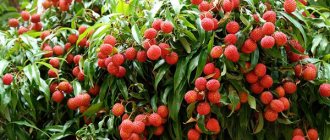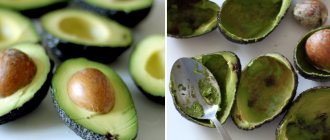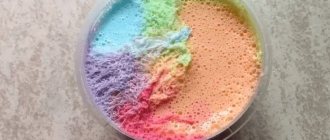In the tropical regions of our planet, the mango tree is considered an important agricultural crop. It has been cultivated there for more than 8 thousand years. The birthplace of this culture is the border areas of India and Myanmar. In Europe, this exotic plant appeared only in the middle of the last century.
Mango tree - description
The evergreen mango tree, which grows in nature and belongs to the Anacardiaceae (Sumakhov) family, is considered an Indian national symbol. The height of the mango tree ranges from 10 to 45 m. It has a thick, lush crown up to 10 m in diameter. However, for growing on a personal plot, small trees are considered more practical. The main root of mango goes into the ground to a depth of 6 m. In order to support a large crown, the plant forms a wide root system with many additional roots.
What does a mango tree look like?
Young leaves appearing on the tree initially have shades ranging from brown-red to yellow-pink. Gradually they become dark green, with a glossy sheen on the top and a light underside. The shape of the leathery leaves can be different: from elongated-lanceolate to oval. A mango tree at home does not grow as tall as in nature, but is very decorative. To cultivate mangoes at home, it is better to use dwarf varieties. The taste of mango fruits is unusual and combines a mixture of fruits and pine needles.
How does a mango tree bloom?
Those mango trees that grow in nature bloom in late winter - early spring. The frequency of their flowering also varies. In some varieties, buds appear once a year, others - 3-4 times during the same period, and there are also those that bloom the whole year. The abundance of flowering largely depends on the climate of the area where the tree is grown. Thus, the dry period promotes intensive flowering, and high humidity prevents the formation of flowers.
In large pyramidal inflorescences up to 40 cm long there are small yellow, white, pink flowers, the number of which can range from 200 to 4000 pieces. They have a pleasant smell, reminiscent of lilies. It is possible to achieve mango flowering at home, even if the tree is grown in a greenhouse, in very rare cases, but in nature it blooms for the first time only 5-6 years after planting. To speed up fruiting, plants are grafted with buds from already flowering trees.
What you need to know about mangoes
A few words about how mango grows in natural conditions. Information will be needed to make it clear what conditions need to be created.
First. The plant is native to India. From there it spread throughout Asia, Africa and even into the southern United States. Extremely thermophilic, cold is deadly for him. Already at plus 5, the mango dies.
Second. This is a large tree. In nature it reaches 20 meters in height, has a huge spreading crown, the roots can go 20 meters deep into the soil. And he needs space in the house.
Lives long - up to 300 years. The fruits grow in groups - from two or more, reaching a length of 5-22 cm. Weight - 0.25-0.75 kg.
Is it possible to grow a mango tree from a seed?
This plant has tasty fruits that contain many different useful substances. Is it possible to grow a mango tree in a pot? This question interests many lovers of indoor plants. Experienced gardeners advise to do this by taking a seed from a ripe or even overripe fruit, which can be red, yellow, green and even black. The shape and size of these fruits also vary: round and oval, large (up to 25 cm in diameter) and small (up to 6 cm). A well-ripened seed should be easily separated from the pulp.
Location and lighting
Growing mangoes requires certain rules:
- For the rapid growth and development of a mango tree, you need to choose the most illuminated place in the house (apartment) - this is the main thing.
- The pot must be large; the root system of the plant develops at a rapid pace. Mango loves the sun very much, so a lack of light will lead to various diseases.
- The optimal temperature during the year should be from +20o C to +26o C; deviations from the norm can have a detrimental effect on the development of the plant. In winter, minimum + 18 degrees Celsius.
How to plant mango?
Many lovers of exotic plants will be interested in learning how to plant a mango seed. To grow homemade mango, you must follow certain rules. The peel of a mango that is taken for propagation should be smooth, without spots or other defects. If you select a fruit that is not quite ripe, but large and beautiful, then it can be placed in a dry, warm place for ripening. The ideal option would be to buy fruit in late spring or early summer, since during this period they are not treated with preservatives for further storage.
How to prepare a mango seed for planting?
To grow a mango tree from a seed, you must first prepare planting material:
- Remove the skin from the entire surface of the fruit, cut the mango lengthwise and carefully remove the seed.
- Carefully scrape off the remaining pulp from it, otherwise they will rot in the ground in the future.
- To speed up germination, you need to split the seed and remove the embryo, which looks like a large bean.
- If the shell is very hard, then you should not crack it so as not to damage the seed. It is better to put it in water and leave it for several weeks in a well-lit place.
Soil for mango
In order to figure out how to grow a mango tree at home, you need to know what kind of soil this plant needs. It needs loose soil of neutral acidity. It is best to choose a cactus mixture in the store, which is ideal for homemade mangoes. If such soil is too dense, you can mix it with perlite, adhering to the ratio: 2 parts soil to 1 part perlite.
The homemade mango tree will not grow in loamy soil. If it is not possible to purchase ready-made soil, you can make it yourself. To do this, mix perlite, peat and coconut substrate in equal proportions. Such a soil mixture must be checked for acidity, and only after that can it be used for planting.
Mango pot
Since the mango tree has a taproot system, based on this, it is necessary to choose a container for its cultivation. The pot for it must be very deep. For an adult plant, a tub would be an ideal option. However, during germination and the first 1-2 years, you can keep a small mango tree at home in a pot up to 20 cm deep or in a 5-liter bottle with the neck cut off. A third of the container should be filled with drainage: broken bricks or small crushed stone, and soil should be poured on top.
Mango planting rules
–
In the middle of the container with the prepared soil mixture, a depression is made into which the sprouted mango seed is placed and sprinkled with earth. If the stem shoot is too large, then it should not be buried. Planting a mango will be successful if the pot, to create a greenhouse effect, is covered on top with plastic film or a two-liter plastic bottle placed bottom up.
Requirements for containers and soil
When choosing a planting container, you need to take into account the following features: the plant has a taproot, rather long, root system, so you need to immediately prepare a tall, spacious pot, especially since the young seedling should not be replanted often. Too large will also not work - the roots in it can rot due to insufficient aeration through the thickness of the earth. The pot must be equipped with drainage holes (plastic ones usually have holes marked that need to be pierced with a hot knife or nail) and a tray.
Mango loves loose, fertile soil
For planting, you can purchase ready-made soil with a neutral alkaline reaction, or you can independently mix garden soil with peat, sand and vermiculite (perlite) to increase looseness, water and air permeability.
Before filling the pot with earthen mixture, do not forget about the obligatory drainage layer, which is made 5 cm high using expanded clay, small pebbles, and broken bricks.
Mango tree at home - care
Experienced gardeners know that a mango tree, which is not easy to grow at home, must receive proper care for proper development. Since it loves light and warmth very much, it must be kept in the most illuminated place in the home. It should be remembered that direct sunlight is not harmful to the tree, but is even important. The room temperature should be maintained at +23…25 ºС.
How to water a mango?
Those who want to learn how to grow a mango tree should remember that the optimal soil for this exotic plant is moderately moist soil. In this case, the humidity in the room should be maintained at 70%. Occasionally it can be sprayed with warm water from a spray bottle. It is better to do this procedure in the evening or early in the morning, and to prevent drops of water from remaining on the leaves under bright sunlight, it is advisable to blot them with a soft cloth, collecting the remaining moisture. In summer, mangoes should be watered once every 2-3 days, avoiding drying out. In winter, watering should be reduced.
How to fertilize mango?
Until the third pair of leaves appears on the young plant, it does not need any additional feeding. Mango tree, when grown as a potted crop, requires the use of fertilizer. To do this, in spring and summer you can use vermicompost or any nitrogen-containing mixtures. The street mango tree needs to be fertilized with organic fertilizer. During the flowering period, the plant needs an increased rate of nitrogen fertilizing.
How to trim a mango?
To form a beautiful crown of a tree, mangoes must be pruned. This procedure is first carried out when the height of the plant is about 1.5 m. Often the topmost shoot is removed so that the branches of the tree begin to grow in width. Pruning is done twice a year, at the same time removing broken or dried stems. This event only benefits the plant, since after it the leafy part becomes thicker. The cut areas should be treated with charcoal or garden pitch.
How to graft mango?
You can get a mango tree at home with fruits only if it is grafted. This procedure is carried out in the summer, for this you need:
- Take a sterile sharp knife and use it to cut a bud with a piece of wood from a fruiting tree.
- On the trunk of a young tree, not far from the surface of the ground, make a T-shaped cut in the bark.
- Carefully bend the edges and insert the cut bud there.
- Press the grafting site tightly and wrap it with electrical tape, which can be removed after about 2 weeks.
Those who are interested in how to grow mangoes at home should know that such a vaccination will guarantee the mandatory fruiting of mangoes grown at home. The first fruits may appear only 1-2 years after grafting. If the plant throws out a flower panicle next year, it must be removed after all the flowers have bloomed. A grafted tree needs regular fertilizing with nitrogen-containing fertilizer. At first there will be only a few mango fruits, but after 3-4 years their number will begin to increase.
Mango diseases
Many tropical crops are very vulnerable to pests and diseases. The homemade mango tree is no exception. Often this plant can be affected by:
- Spider mites
. These common mango pests feed on plant sap, inhibiting them. A red coating appears on leaves affected by mites. Having discovered it, healthy leaves and stems must be treated with an insecticide, and damaged ones must be removed. - Anthracnose
. This fungal disease occurs due to high humidity. Dark brown and then black spots appear on the leaves. The plant gradually dies. To cure a tree, you need to completely replace the substrate and disinfect the roots in a solution of potassium permanganate. - Bacteriosis
. The disease occurs due to bacteria that can enter the plant through untreated cuts during pruning. The tissues gradually begin to rot, emitting an odor uncharacteristic of this plant. Having discovered such damage, it is necessary to completely remove the rotting parts of the tree and replace the soil. Healthy branches are treated with Bordeaux mixture or copper sulfate.
Sprouting the seed
- Remove the pit. To do this, cut the fruit into two halves, pry the pit with a knife and remove. Clean it up. Wash in water.
- Take out the seeds. In order for sprouts to appear faster, you need to free yourself from the hard shell. Of course, you can do without this stage, but due to the fact that the seed is very strong, and the climate in Russia is often not tropical, the mango may not germinate. Even a growth stimulator won't help. It is better to insert a sharp knife into the side of the pit, turn it, open the shell and carefully remove the contents. The “naked” seed looks like a large bean.
- Treat with a fungicide - this will destroy parasite spores and mold.
- Take a piece of cloth or paper towel, wet it, but not too much, and wrap the seed.
- Create a greenhouse. Place the package in a plastic bag, place it in a food container, and close the lid.
- Place in a dark place and check every day to see if the material is dry.
Clarification. If the bone is too hard and does not give in, put it in a glass bowl, pour water into it, place it where it is light and warm and wait. After about two weeks, try opening it again.
Another option for a greenhouse is a container with sawdust soaked in water. The seed is placed in it without wrapping.
If everything is done correctly, the seed will germinate in 2-3 weeks.
How to replant a mango?
After the mango tree has grown to about 1.5 m, it will need to be transplanted into a larger container, since by this time the root system occupies almost the entire volume of the pot. Replanting mangoes should be done in the spring, at a time when the roots are growing very intensively. The new container should be approximately 5 cm larger than the previous one. It is better to replant using the transshipment method. For the first three years, the plant is replanted annually, then once every two years, and only then the tree can be planted in a large tub.
Plant care
Further cultivation of the seedling is not particularly difficult. The main thing is to ensure:
- sunny location - south window sill;
- regular watering - 1-2 times a week with settled water at room temperature;
- daily foliar spraying.
This type of care is recommended for all non-hairy indoor plants that come from the tropics.
Mango loves irrigation with water from a spray bottle and shower head, wiping the leaves with a damp cloth, and open air in the summer on a balcony or terrace.
Feed the tree with universal complex fertilizer for indoor plants during watering.
A period of rest in winter is not required, but additional lighting with a phytolamp is welcome.
To form a crown at the 8-leaf stage, it is necessary to pinch the tip of the shoot.
Annual spring pruning is carried out when the plant reaches one and a half meters in height.
For the first three years, the tree is replanted once a season, selecting a pot or tub of the required (larger) size; subsequently, it is replanted once every three years.
How to propagate mangoes?
This evergreen tree can be propagated in two ways:
- By cuttings
. To do this, cut off the upper, non-lignified parts of the shoots about 10-15 cm long and root them in the sand. In this case, you can use stimulants to speed up root formation, which often occurs within a month. However, in this way you can only get a beautiful ornamental plant. - Vaccination
. In order to grow a fruit-bearing mango tree, it is necessary to graft it. First, a seed is sprouted from a seed, then a sprout of a mango tree is planted in the ground, and in the second year of life, the young plant is grafted in the manner described above. This way you can get a tree with a compact crown, which is especially important when growing it at home. After 1-2 years, the owner will already be enjoying delicious and healthy mangoes grown with his own hands.
Secrets of successful landing
For high-quality germination and obtaining a developed seedling, in addition to processing, the seed also needs to be planted correctly. This can be done in several ways.
- Spine down. This is the most correct and rational immersion of a small embryo in the soil mixture. The roots will not get mixed up, they will germinate well and take up the entire pot. The tubercle on the seed with the red dot is the future root system.
- Place the “bean” on its side. Sometimes the question arises: where is the top and where is the bottom of the embryo, where will the stem grow from, and where will the roots come from? Place the embryo on its side, and it will turn itself where necessary.
- Horizontally. If the sprout has hatched, place it horizontally to the surface of the soil - this position will be the most successful.
A seed planted in moist soil with a hatched embryo or the embryo itself is covered with about a couple of centimeters of soil on top. Remember, there is no need to compact the top layer; let the soil remain loose, this will give access to oxygen and moisture. The planting is slightly moistened with a spray bottle, the container is covered with glass or polyethylene, and sent to germinate in a warm place on a window sill. During the week, the shelter should be removed two or three times to ventilate the soil and air in the constructed greenhouse.
Initial care
When a shoot appears, it is necessary to continue to keep it in the greenhouse for some time. Then begin to gradually accustom the young plant to the ambient air in the room, daily increasing the time it spends outside the “greenhouse”.
Young mango sprouts are very tender and direct sunlight can damage them. But when the first leaves appear, the need for light increases sharply. It is advisable to move the pot to a southern window sill.
Selection and preparation of seeds
In order to germinate a mango seed, it is important to choose the right fruit. It must be fully ripe, but not spoiled. When choosing, pay attention to the following parameters :
- Appearance of the peel . It should be smooth and shiny; a wrinkled surface indicates the unripeness of the fruit. You shouldn’t pay much attention to the shade; the color depends on the variety of mango; some varieties can be ripe even with green peel. It is important that the fruit is free of mold, rot, holes, suspicious spots and growths. These signs indicate that the plant was damaged during fruiting by diseases and pests that could reach the seed. Small dark specks are not a sign of infection, but evidence of maturity.
- Softness and elasticity . Ripe fruit should be easily pressed. A slight pressure quickly smoothes out the dent.
- Smell . A ripe fruit emits a characteristic pleasant aroma even when uncut. Green mango has almost no smell. Overripe fruit has an alcoholic odor.
If you were unable to purchase a ripe mango, you can ripen the fruit at home . It should be placed in a paper bag and placed near apples or bananas. In 2 days it will ripen.
Advice! Suitable for planting are the seeds of overripe, but not rotten, mangoes, the pulp of which is crushed but does not return to its previous shape. This fruit has an unpleasant taste.
The mango seed resembles a clam in appearance . It is taken out, washed, and the remaining pulp is removed.
If possible, you should crack the shell without touching the kernel . The core is removed from the shell. If several sprouts are found inside, choose the strongest one. The rest can also be planted.
The core is soaked in a light pink solution of potassium permanganate for 15 minutes. Fungicides or biologicals can also be used. This will protect the plant from infection by fungal diseases in the future.
If the shell does not yield , place the seed in a transparent container, fill it with water at room temperature, place it in a warm place and wait for the flaps to open and a sprout to appear. The water needs to be changed every 2 days.
Note! Often a seed that has already sprouted is found in the shell. Such planting material is not soaked, but is immediately planted in the ground.
Dangerous pests and diseases
Spider mites are a big danger for tropical trees. Their sign is the appearance of a cobweb. The cause may be high temperature and lack of humidity. In warm weather - thrips, which feed on the sap of leaves. This can be seen by changes in color or discoloration of the leaves.
What work needs to be done in the fall to prepare fruit trees for winterPlanting and replanting trees in autumn: recommendations from experienced gardeners
What are the benefits of pomegranate for health and immunity?
Common Mango Diseases:
- powdery mildew - white coating on leaves;
- bacteriosis - spots on leaves;
- anthracnose
Dry air will turn the tips of the leaves brown. And when it gets cold, the flowers will simply fall off.
Top dressing
To form a beautiful crown of a tree, we need to fertilize it in early spring - this is a time of rapid growth. Organic fertilizers should be added to the soil once every 2 weeks: in spring and summer. Additionally, 3 times a year you can feed with microfertilizers.
Mangoes should not be fertilized in autumn. For the proper development of the tree, it is better to choose the right balanced fertilizer, then the plant will delight its owners with delicious fruits.
Reproduction and care
Previously, mangoes were propagated by seeds or grafting. Plants are grafted only in summer, which guarantees results. Any soil will do, but the soil must be loose and have good drainage.
10 best frost-resistant peach varietiesWinter-hardy varieties of apricots: the best, tasty, frost-resistant varieties
How to plant trees in the fall: timing, planting stages and varieties
The grafted young tree tries to bloom early and bear fruit, but the panicle with flowers must be cut off after full bloom. It will be possible to leave the inflorescences only after 1-2 vaccinations.
Trim the plant by 1/3 in the spring, and pinch the tops so that it bushes better. But pruning delays flowering. Transplantation is possible in the spring.
How to choose the right fruit for planting
When choosing a fruit in a store for further germination, you should pay attention to its ripeness. The shade in this case does not play the most important role.
Pressing on the fruit will help you make the right choice; it should be quite elastic; hardness or severe deformation are considered bad indicators. Preference should be given to fruits with intact skins without spots on the surface.
The ripe fruit is characterized by a sweet smell; the aroma of alcohol indicates the beginning of fermentation. When peeling, the pulp should be easily separated from the core.
Common mistakes when planting mangoes
Failure to follow planting rules may result in the plant not germinating or quickly dying. The most common mistakes:
- Doesn't fit. If you bury the entire bone, the shoot will not have enough strength to break through the thick layer of soil. There is also a high probability that the seeds will simply rot. If the seeds are left on the surface, the seedling will not have enough moisture and will not germinate.
- Irrigation with cold water. Mango, like all tropical plants, is very sensitive to temperature changes. Low water temperatures can cause hypothermia of the plant and, as a result, loss of foliage. In addition, improper watering can provoke the development of fungal diseases.
- The wrong pot is being used. The capacity corresponds to the size of the plant. A vessel that is too deep causes the development of the taproot to the detriment of the above-ground part. The sprout will wither and die. In a container that is too shallow, the root system will not be able to fully develop.
- Unsuitable environmental conditions. For the first 2-3 months, mangoes are grown in greenhouse conditions. This will protect it from changes in temperature and humidity. The greenhouse is removed gradually, after the sprout has become stronger and accustomed to environmental conditions.
Planting a seed and getting the first few shoots is half the battle. In order for the plant to be healthy and pleasant to look at, it is necessary to strictly follow the rules of caring for the seedling.











